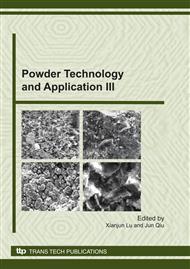p.219
p.224
p.233
p.241
p.248
p.256
p.262
p.273
p.281
Study on Microstructure Variation Laws of Al-Pillared Montmorillonite
Abstract:
Al3+/clay ratio is one of the important factors influencing microstructure of Al-pillared montmorillonite. Microstructure variation laws of Al-pillared montmorillonite prepared under the condition of different Al3+/clay ratio are systematically studied by XRD, FTIR, specific surface area and pore size analysis. The results show that the interlayer spacing and BET specific surface area of Al-pillared montmorillonite are remarkably affected by the Al3+/clay ratio. The interlayer spacing d(001) value and BET specific surface area of Al-pillared montmorillonite increase firstly and then decrease with the increases of the Al3+/clay ratio, and they reach to maximum when the Al3+/clay ratio is 10mmol/g. Besides, the BJH porous volume distribution of Al-pillared montmorillonite is the most probable distribution, and the most probable pore size is about 2 nm, which is attributed to mesopore. The porous structure of hydroxy-Al pillared montmorillonite is characterized as parallel plate slit or “house-of-cards” wedge-shaped pore which is formed by novel meso-microporous delaminated structure and fragments. With the increase of the Al3+/clay ratio, BJH total porous volume and mesoporous volume of hydroxy-Al pillared montmorillonite decreases, while the proportion of microporous volume in the total porous volume increases. The proportion of microporous specific surface area of all the hydroxy-Al pillared montmorillonite samples is about 62% and is much larger than that of Na-M and those of mesopore and macropore, indicating the main action of intercalation of hydroxy-Al pillaring solution into montmorillonite interlayer is to increase the micropore amount.
Info:
Periodical:
Pages:
248-255
Citation:
Online since:
November 2010
Authors:
Price:
Сopyright:
© 2011 Trans Tech Publications Ltd. All Rights Reserved
Share:
Citation:


